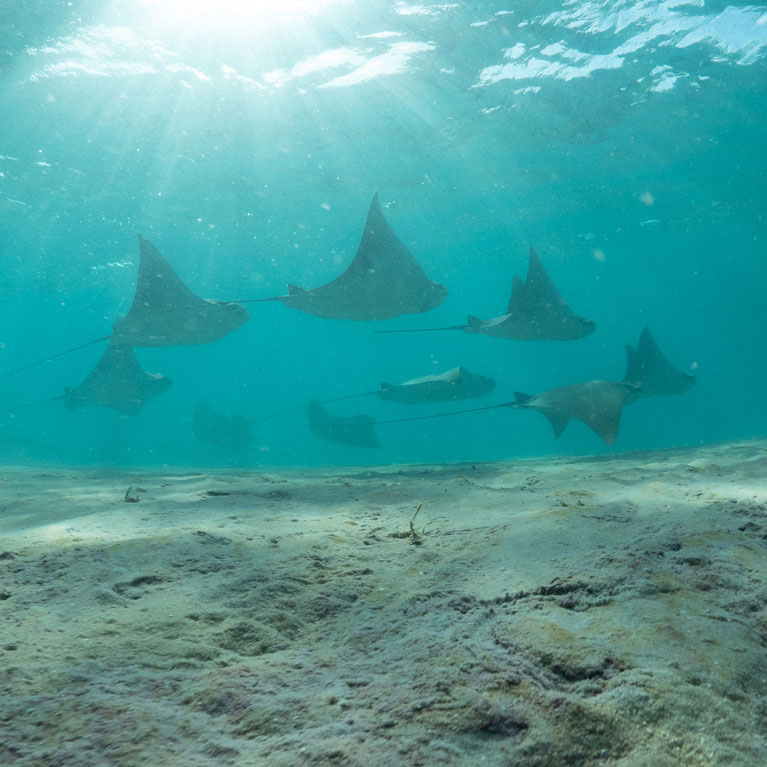Making sense of sharks, electromagnetic fields and magnetic senses
In a world where mitigating climate change is critical, the US development of offshore wind energy infrastructure along its coastline could be an important step. But what are its consequences? The sensitivity of sharks and rays to electrical and magnetic fields allows them to detect the bio-electric fields emitted by their prey. Kyle wants to know how the wind energy infrastructure will affect these super senses and impact the sharks’ and rays’ movements, distribution and choice of remaining coastal habitats. He’ll be tagging sharks and using lab-based behaviour models to ultimately understand how sharks will respond to the development of the infrastructure.
I was born in the Philippines but grew up in Seattle, USA, where I learned to appreciate the value of a dry suit while earning my scuba certification. I received a BSc in marine science and biology from the University of Miami, then worked for a biotech start-up in Seattle. Eventually I moved to Los Angeles and got my MSc in biology from California State University Fullerton, where I showed that visceral endothermy gives the endothermic mako shark a selective advantage in food processing rates compared to sympatric ectothermic sharks. I went on to receive my PhD in...
The Impact of Anthropogenic Electromagnetic Field Noise on the Behavior and Movement of Elasmobranchs
I am particularly interested in how the electromagnetic field noise generated by offshore wind energy facilities impacts the foraging and navigation behaviour of electrically and magnetically sensitive species, such as sharks, rays and skates.
The development of offshore wind energy infrastructure will modify oceanic habitats and result in networks of high-voltage submarine cables to transport electricity back to shore. However, the effect of electromagnetic field noise emitted by cables on elasmobranchs is not known. If electromagnetic fields mimic the bio-electric fields produced by prey, elasmobranchs could forage in unproductive areas or overlook prey. If they alter the local geomagnetic landscape, it might create navigational barriers or cause migrating elasmobranchs to veer off course.
Elasmobranchs can detect the bio-electric fields produced by prey, predators and conspecifics and the geomagnetic field that they use to navigate during migrations. Elasmobranch electromagnetic field detection experiments have focused on their general sensitivity to natural electrical and magnetic field components. However, their response to anthropogenic electromagnetic field emissions has not been assessed.
To mitigate the effects of climate change, the US government is developing offshore wind energy infrastructure along its coastline. The electricity conducted through inter-array and export submarine high-voltage cables emits magnetic field artefacts into the surrounding sea water and induces electric field artefacts for several tens of metres. The intensity and characteristics of these fields are above the detection threshold of elasmobranchs, which suggests there is a potential for electromagnetic fields to influence their behaviour, physiology and ecology. The behaviour of an organism is its first line of defence against rapid environmental change, so comprehensive research on the potential physiological and behavioural effects of offshore wind energy infrastructure on elasmobranchs that migrate through or spend major life stages in offshore wind lease areas is needed.
We are part of a multi-institutional programme that combines laboratory and field studies to quantify the behavioural response of various elasmobranchs to the electromagnetic field noise emitted by offshore wind energy facilities. Our goal is to use data from controlled laboratory experiments to ground truth the data collected on the electromagnetic field responses of elasmobranchs in the wild. These field data will be used to improve baseline habitat suitability and species distribution models for sentinel elasmobranch species sourced from federal and state survey programmes. The models and continuing field studies will be used to monitor the long-term impacts of offshore wind energy infrastructure by mapping out the spatio-temporal dynamics of elasmobranchs before, during and after construction.
Our overall aim is to determine whether electromagnetic field noise impacts elasmobranch behaviour and we will achieve this by:
- Quantifying the behavioural response of elasmobranchs to electromagnetic field noise in the laboratory.
- Creating a baseline electromagnetic field behavioural response model.
- Tagging elasmobranchs in offshore wind lease areas before construction begins.
- Tagging elasmobranchs in offshore wind farms after construction is completed.
- Using lab-based electromagnetic field behaviour models to validate tag data to understand how elasmobranchs respond to electromagnetic field noise in the wild.
- Using field data to determine how electromagnetic field noise affects elasmobranch movement, distribution and habitat suitability.


